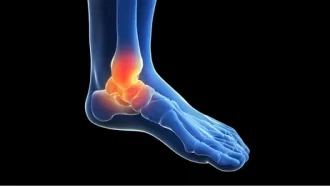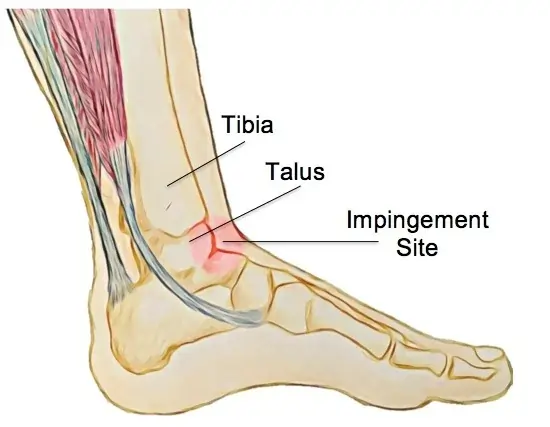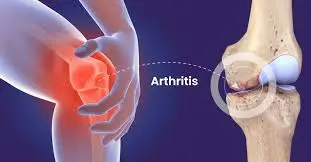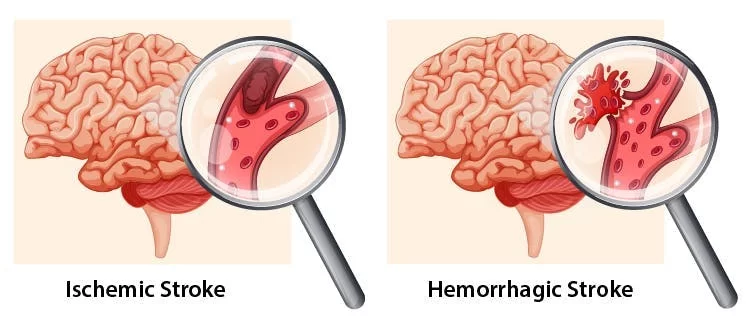Ankle Joint Stiffness
What is an Ankle Joint Stiffness?
Ankle joint stiffness is a common condition affecting the range of motion and flexibility of the ankle, leading to discomfort, limited mobility, and sometimes pain during daily activities. Often caused by injury, inflammation, prolonged immobility, or underlying joint disorders, stiffness in the ankle can affect balance and movement patterns, potentially impacting overall physical health.
Understanding its causes and symptoms is essential for appropriate treatment and prevention, which may include physiotherapy exercises to restore flexibility, strength, and functional mobility in the joint.
Anatomy of the ankle joint
Articulating Surfaces
Three essential places of articulation make up ankle joints: Solid tibiofibular tendons connect the tibia and fibula, which are the leg bones at the lower leg’s distal end. The ankle joint basically permits the foot to move in both plantar and dorsiflexion, with a few restricted inversion and eversion possible through the subtalar and midtarsal joints.
Pathophysiology of the ankle joint stiffness
Ankle joint stiffness advances through four stages
- Bleeding
- Edema
- Tissue Granulation
- Fibrosis of Granulation Tissue
Stages of the stiff ankle joint
Stage 1 – Minor
The ankle joint shows minimal wear and tear, as well as a laceration, with little to no pain in the affected location.
Stage 2 – Mild
The affected ankle joint has further apparent bone spurs; the region becomes stiff after sitting for extended periods. Individuals may require the brace.
Stage 3 – Moderate
Cartilage in a damaged area starts to break down, and the ankle joint gets bothered and produces pain when performing routine tasks.
Stage 4 – Severe
The patient’s ankle joint is inflamed as a result of almost complete cartilage loss, and they are in severe pain. Bone spur overgrowth, called osteophytes, can result in terrible pain.
Causes of Ankle Joint Stiffness
- Nerve Damage( Neuropathy)
- Ruptured Tendon
- Trauma
- Tumors
- Post Operative Joint Stiffness
- Ankle joint immobilization following a multiple fracture.
- Rheumatoid Arthritis of Ankle
- Achilles Tendonitis
However, Achilles tendinitis is most likely the cause, If one ankle is more hardly stiff than the other. Ankle pain is more directly associated with a bothered Achilles ligament, however, it can moreover influence stiffness following a night’s sleep.
Osteoarthritis: This age-related form of joint pain happens due to the declination of protective cartilage, which gives softening for our joints and permits for liquid movement. Joint pain in the ankles might develop as a result of the extreme weight and strain that the ankles bear every day. Without cartilage to cover them, the ankle joints can quickly become inflamed and tight, particularly in the morning.
Sprain or strain: Sprains and strains are the outcome of injuries to the ankle’s softer tissues. This ailment might be a strained ligament or tendon. Most sprains and strains recover in a few weeks, however, they may stiffen beyond a few weeks if treatment is not possible..
Symptoms of Ankle Joint Stiffness:
Inflammation or injury to the muscles, ligaments, tendons, cartilage, joint space, or bones in this region may be the cause of ankle pain.
Ankle pain may be connected to further symptoms like
- ankle swelling
- bruising
- redness
- numbness or tingling
- instability
- burning pain
- a painful weight-bearing ankle injury
- stiffness
- weakness.
Diagnosis:
The following physical examination will be performed by a doctor to determine whether the ankle is stiff:
Observation: The doctor will evaluate the differences between the damaged and undamaged ankles.
Palpation: The physician will softly touch around the ankle to detect pain and determine which ligaments are affected.
Assessing range of motion: The doctor could move the ankle in various planes.
An X-ray, ultrasound, or magnetic resonance imaging (MRI) can be performed to assess the soft tissues, joints, and bones around the ankle. Blood testing may be used in some circumstances to find underlying medical issues.
Treatment of Stiffness of ankle
Medical treatment
Symptomatic Treatment pain-relieving NSAIDs (nonsteroidal anti-inflammatory medicines) and hot and cold packs applied twice daily can help reduce joint pain, edema, and stiffness.
Physiotherapy treatment of Stiffness of the ankle
Electrical modality
Ultrasound (US): The US is mostly used to treat tenderness and relieve pain.
Transcutaneous electrical nerve stimulation (TENS): This method relieves pain and reduces redness and swelling.
Wax therapy: The main benefit of this treatment is that it helps the patient feel less pain, which promotes range of motion.
Exercise for Stiff ankle
- Mobilization
- Stretching
- Range of motion Exercises
- Strengthening exercises
- Home exercises
Mobilization: To address joint problems, improve range of motion, and reduce pain following an accident, ankle joint mobilizations are performed.
Ankle Anterior Glide:
Indication: Improve the plantar flexion
Position: Placing the foot prone with its edge just over a table’s edge, then mobilizing the hand on the posterior calcaneus, slightly distal to the joint line, and stabilizing it beneath the anterior distal tibiofibular joint.
Mobilization: Provide a downward, anteriorly inclined push on the calcaneus when implementing mild traction.
Ankle Posterior Glide
Indication: Improve dorsiflexion
Position: supine with the foot slightly over a table’s edge; the mobilizing hand grasps the anterior ankle slightly distal to the joint line, and the stabilizing hand is under the posterior distal tibiofibular joint.
Mobilization: Apply the downward, posteriorly orientated push to an ankle while applying mild traction.
Stretching
Stretching exercises can enhance athletic performance, lower the chance of injury, help joints move through their complete range of motion, promote blood flow to the muscles, maximize the efficiency of the muscles, and enhance daily activities.
Sitting plantar fascia stretching exercise
First, instruct the patient to place the base of their toes on the ground and cross their foot over the contralateral knee. Then, carefully drawback until the patient feels a stretch on the underneath of their foot. One repeat of this position should last thirty seconds. In each session, repeat three times. Spend three hours each day exercising.
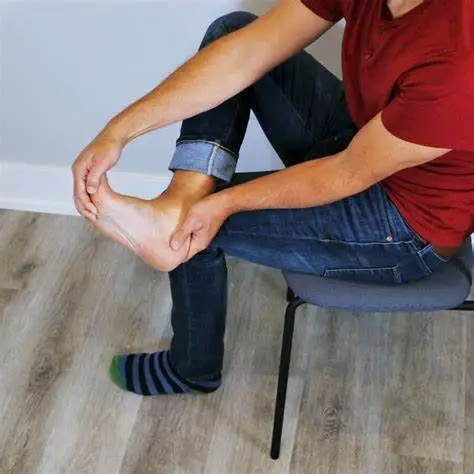
Standing calf stretch
The patient must place both hands on the wall in front of them while standing with their back on the wall. Bend the front knee slowly until the patient feels a stretch in the lower thigh or back calf. Three times in a single session, hold the posture for thirty seconds, release it, and take a step back to the neutral position. Spend three hours each day exercising.

Cross-leg ankle stretch
First, the therapist should instruct the patient to sit comfortably with the affected leg crossed over the non-affected knee. Next, bend your left ankle and toes downward and continue to point with your right hand to your toes while still holding onto your right foot. This exercise should stretch both the front of the ankle and the foot for the patient. Hold it three times in a single session for thirty seconds each. Work out three times a day.
Range of motion exercise
Active ankle circles
This exercise might increase the range of motion. A patient may perform ankle circles while seated or lying down. Utilizing an injured foot to draw the letters in the air might be a more reasonable activity for a patient. Take the big toe and lead it. continue to work out gradually and concentrate on exercising only your foot and ankle — not your total leg. Attempt counting to 10 with the injured foot in each direction when performing circles. However, perform three sessions of the ABC on the affected foot each day, If a patient is doing it.
Toe extension
Instruct the patient to perform the exercise by sitting up straight on the chair with their feet level on the ground. The affected foot should then be put on the normal thigh. Pain and tension can be diminished by stretching and relaxing the foot’s arch. In one session, perform 10 repetitions. Work out three times a day.
Toe flexion
The patient should be educated to sit up straight in the chair and then have their feet level on the ground. Following, the foot that’s injured should be put on the leg that’s healthy. In one session, perform 10 repetitions. Exercise for three hours each day. Buy vitamins and supplements
Active dorsiflexion
Ask the patient to get into a comfortable pose, such as lying on the bed, before beginning. The patient should next be educated by the therapist to bend their foot as far upward and towards their face as possible. Do 10 reps in a single session. Exercise for three hours each day.
Active plantarflexion
The patient should be educated by a physical therapist to move their foot down from their body, which means as far down as they can do without being held. Exercise for three hours each day.
Heel raises
Begin with heel raises while your feet are level with the ground. In a single session, repeat ten times—exercise for three hours each day.
Summary
Before proceeding with any new stretches or exercises, continuously get your doctor’s advice, particularly if you’ve recently had surgery or been injured. However, you may need to spend four to six weeks on a specific strength and stretching program, If you have just had surgery or an injury.
Your therapist may have characterized certain exercises and suggestions that you require to take as you heal. However, you may find that extending your ankles improves general pain and stiffness as well as your range of motion. To learn further about extra ways to strengthen and flex your ankles, counsel your doctor or physical therapist. However, a certified therapist can confirm it for you, If you’re performing these procedures appropriately. It’s crucial to utilize proper form.
FAQ’s
How do you fix a stiff ankle?
Sitting in a chair, bend the leg of the affected foot up onto the thigh of your other leg. Gently bring your foot up and inward towards you. This exercise will improve ankle mobility. Ten repetitions of this will help release a tight ankle.
What causes ankle stiffness?
Arthritis, regular wear and tear, and trauma are the three most prevalent causes. Depending on the cause, the area surrounding the ankle may pain or stiffness. Your ankle will likely swell and become immovable. The use of ice packs, rest, and over-the-counter painkillers can typically alleviate ankle soreness.
How long does a stiff ankle last?
The ankle may swell, become stiff, or pain for several weeks even after using the greatest precautions. Most often, this will occur just after a workout or first thing in the morning.
What does a stiff ankle feel like?
Bone friction and joint edema are the reasons behind ankle stiffness and decreased flexibility. As the ankle’s range of motion narrows, it may become more difficult to point and flex the foot or move the foot side to side.
References:
- Jason.Lee. (2023, July 7). Ankle stiffness | ME Physio. ME Physio. https://mephysio.com.au/blog/ankle-stiffness/
- Physiotherapist, N. P.-. (2023, December 18). Ankle joint stiffness : Cause, Physiotherapy Treatment, Exercise. Mobile Physiotherapy Clinic. https://mobilephysiotherapyclinic.in/ankle-joint-stiffness-exercise/#google_vignette
- Prajapati, N. (2022, June 14). Stiffness of ankle Cause, Symptoms, Treatment, Exercise | Samarpan P. Samarpan Physiotherapy Clinic. https://samarpanphysioclinic.com/stiffness-of-ankle-exercise/

